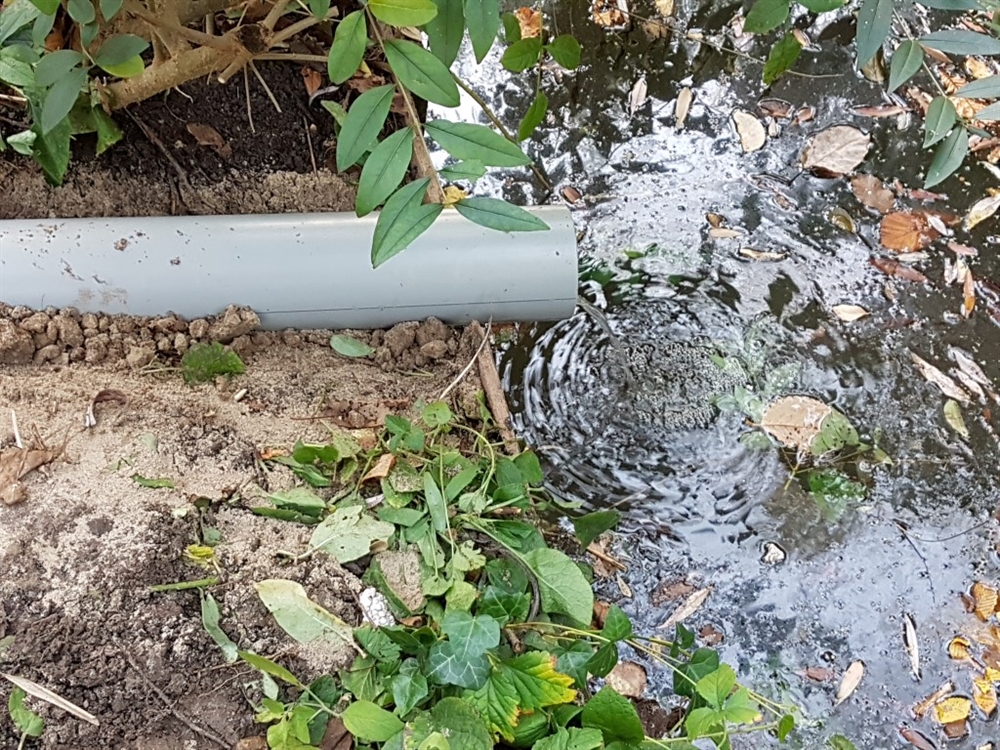Woerden resident uses grant to disconnect his roof from sewer system
The municipality of Woerden is encouraging its residents to disconnect rainwater falling on their roofs from the sewer system. Under the Rainwater Disconnection and Roof Greening scheme, residents qualify for a grant of six euros per square metre of roof, up to a maximum of 250 square metres. The scheme is intended for residents of neighbourhoods serviced by a combined sewage system. The disconnection of downspouts prevents rainwater from draining into the sewers, thus reducing the probability of waterlogging. One of the home owners who have successfully applied for such a grant is the resident of Fort Oranje 23. The grant enabled him to disconnect all his downspouts from the sewer system.
Result
Fort Oranje 23 is located in the Meander neighbourhood in Woerden. Rainwater that falls on the wide-roofed houses in this neighbourhood is discharged into a combined sewage system. The owner of Fort Oranje 23 used the grant to reduce the probability of waterlogging: “Waterlogging is undesirable from both an environmental and social perspective.” He used the grant to disconnect a 200 m2 roof from the sewer system. With some assistance from a local plumber, all downspouts were disconnected.

Image: Roof being disconnected from the sewer system.
Three facilities have been constructed:
- A collecting pipe to drain rainwater from three downspouts to a ditch located behind the house;
- A drainpipe to drain rainwater from one downspout to the ditch located next to the house;
- A drainpipe to drain rainwater from one downspout to the garden, where the water will infiltrate the soil by way of a layer of gravel.

Image: Rainwater is drained to a nearby ditch.
The resident of Fort Oranje 23 is one of 41 home owners who successfully applied for the grant in the past eight months. A total roof surface area of 3600 square metres has been disconnected from the sewer system.
Lessons to be learned: municipality
- Many residents perceive the disconnection of downspouts as rather complicated. Although many residents are motivated to take measures, they are not sure how to disconnect their downspouts. Moreover, every situation calls for a tailored approach. Residents need good information on the “how and what” of disconnecting downspouts, and someone to help them along in the process. This is why the municipality is going to provide better information to interested residents. In addition, the municipality is looking for a downspout disconnection coach to assist residents.
- Many residents applying for a grant tend to saw downspouts through, whereupon rainwater flows into the garden to infiltrate the soil. In such cases, it is not much effort for the next resident to re-connect the downspout to the waste water sewer system: there is no structural adjustment to the facilities. For that reason, the municipality is going to amend the grant scheme: grants will be proportionate to the amount that applicants invest in a structural solution.
- Try to keep the administrative process as simple as possible for both residents applying for grants and municipal staff who deal with the applications. This will raise the appeal of the scheme for both parties. That is why, with effect from 2019, the municipality will eliminate one of the steps – the tentative decision – from the process.
Lessons to be learned from the resident who has disconnected his downspouts
- Do not underestimate the time and effort it takes to disconnect downspouts from the sewer system. It can be quite a puzzle to gain insight into the configuration of subsoil drainpipes and subsequently adjust them. We have consulted with the plumber several times and along the way we had to adjust our plan of action. Fortunately, the municipality allowed us more time to carry out the work.
- The ultimate result is well worth our while! The rainwater drainage works well, and it enhances our garden and ditch.
- The municipal grant scheme enabled us to carry out the project. Without the grant, the work might have exceeded our budget.
- We as residents have organised and carried out the work. It would have been efficient for more residents to take similar measures at the same time. We still have material left.
- A technical lesson to be learned: use sufficiently sturdy and wide drainpipes, especially if working underneath a driveway or garden paths.
Contact persons
Wilco van Bodegraven
Gemeente Woerden
bodegraven.w@woerden.nl
0348 - 42 83 04
Rienk Schaafsma
rienk.schaafsma@waaloord.nl
0348 - 42 51 23
